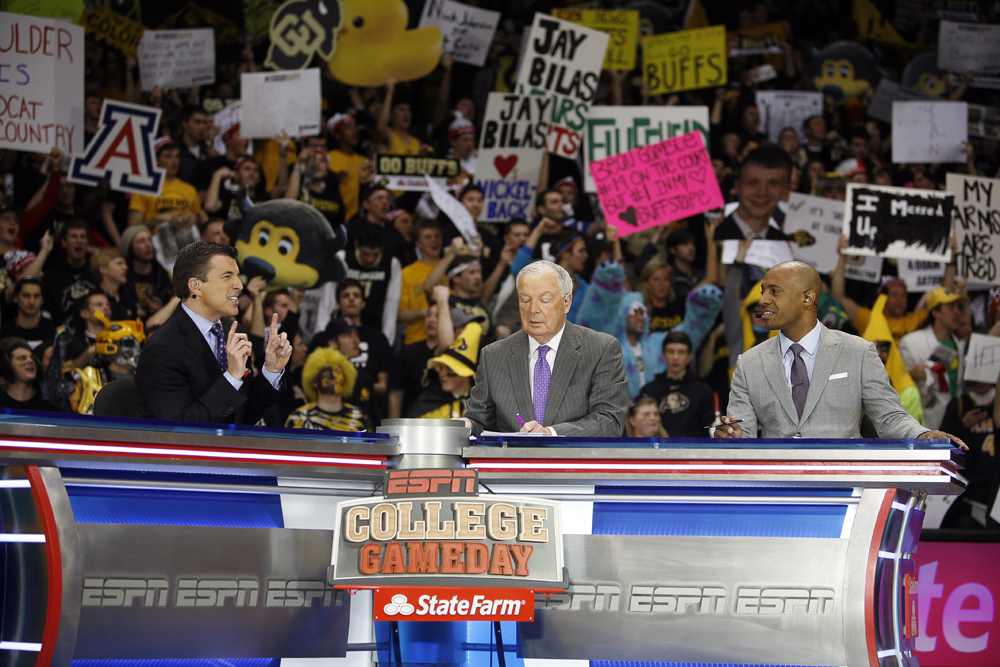
From left to right, Rece Davis, anchor of College GameDay, Digger Phelps and Jay Williams discuss various topics around the college basketball world during the ESPN College GameDay broadcast at the Coors Event Center, Feb. 22, 2014, in Boulder, Colo. (Kai Casey/CU Independent)
Even in 2014, there are firsts for the University of Colorado. The bright lights of ESPN College GameDay made their first-ever trip to Boulder, and to many, it was the highlight of the school year.
While everyone sees the finished product on television, they rarely see the world of production. It is work the public rarely acknowledges or notices, so CUIndependent.com went behind the scenes to give an inside look at what makes college basketball’s flagship show tick.
The University of Colorado officially released that they would be hosting GameDay on January 29, and Assistant Sports Information Director Andrew Green was one of the first in the department to find out. Once the news broke, the work started.
“ESPN GameDay reps had two teleconferences with the important people here — Coors Events Center staff, game operations, marketing, sports information — who work with men’s basketball games, making sure every detail was covered,” Green said.
The details of the morning broadcast and game coverage were taken care of by College GameDay producer Tom Engle and director Michael Roig. The Boulder show was a special case for the team at ESPN, who not only broadcast from here, but also from Durham, North Carolina for the Syracuse University vs. Duke University game.
With the crossover, it was important that the staff on site in Boulder was at the top of their game. While it’s a stressful job, the key to Roig’s and his crews’ success has been in never taking their jobs too seriously. What calms Roig is a tradition of wearing a hat backwards when he directs.
“I always wear a hat backwards, a baseball cap, just [to remind] me I’m a fan of the game as well,” Roig said. “For me, I bring levity, and I want to make sure that trickles down to the crew because if I’m tight then everyone else is tight.”
With the goal of maximum exposure, Roig’s hope was that the coverage brought the traditions and flavor of the Coors Events Center into the homes of people who “have never been to Boulder, who will never come to Colorado.”
Members of the camera crew have very specific assignments during games, with some cameras isoing, or isolating, their shot on individual players, while others are focused on the action in the stands. The key to a good show is mixing those two perspectives, what Roig refers to as “documenting the game, and the pomp [and] circumstance.”
That pomp and circumstance can be anything spontaneous, such as Oklahoma State’s Marcus Smart fighting with a fan a couple of weeks before the CU vs. Arizona matchup. What sets the GameDay staff apart is the camera crew’s ability to be instinctive and the directors’ abilities to make sure everyone is up to speed during the broadcast. While mistakes do happen, it isn’t something that Roig and Engle let get to them. Contingency plans always exist, and having a crew of talent like Rece Davis, Digger Phelps and Jay Williams behind the desk is always reassuring.
“The thing about doing live TV is that you always have to prepare for something to go wrong and, as we say, it’s ‘off to Pluto’,” Engle said. “So if that’s your fallback if something goes crazy, then you’re all right.”
Moving footage from almost a dozen cameras to live streams connecting with ESPN headquarters in the middle of a show provides opportunities for anything to go wrong during a GameDay broadcast. But problems rarely occur. The payoff manifests itself in the splendor and action of places like the Coors Events Center being placed right in viewers’ living rooms.
“If you would have told me six years ago [that] ESPN Gameday would be making a trip to Boulder, I would have never believed it,” Green said.
Roig echoed Green’s sentiments.
“Within the Pac-12, this could be a special place,” Roig said. “I think with the success you guys have had with four 20-plus season wins, I think you could be a top-tier, top four or five, as far as atmosphere and game and team.”
Contact CU Independent Staff Writer Andrew Haubner at andrew.haubner@colorado.edu.
